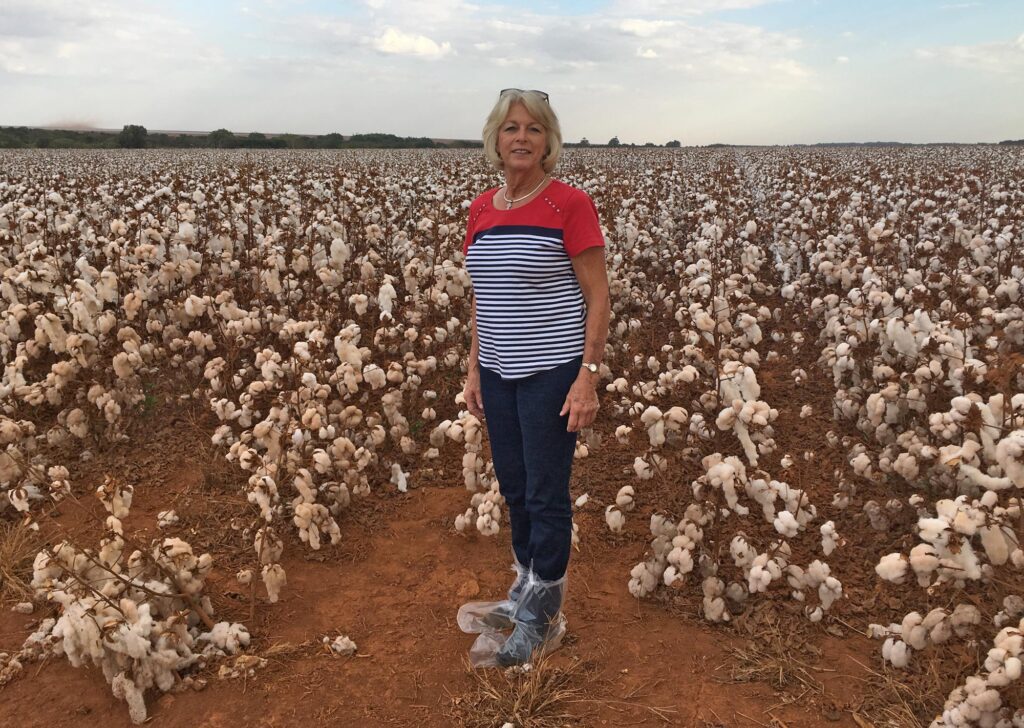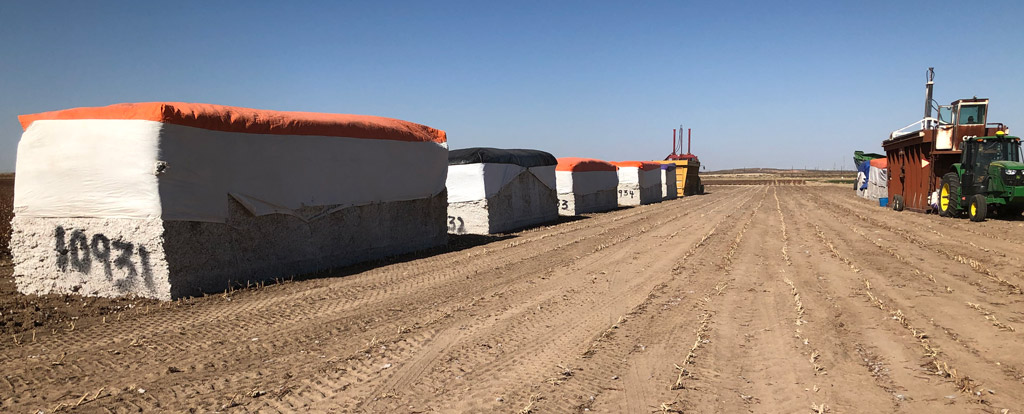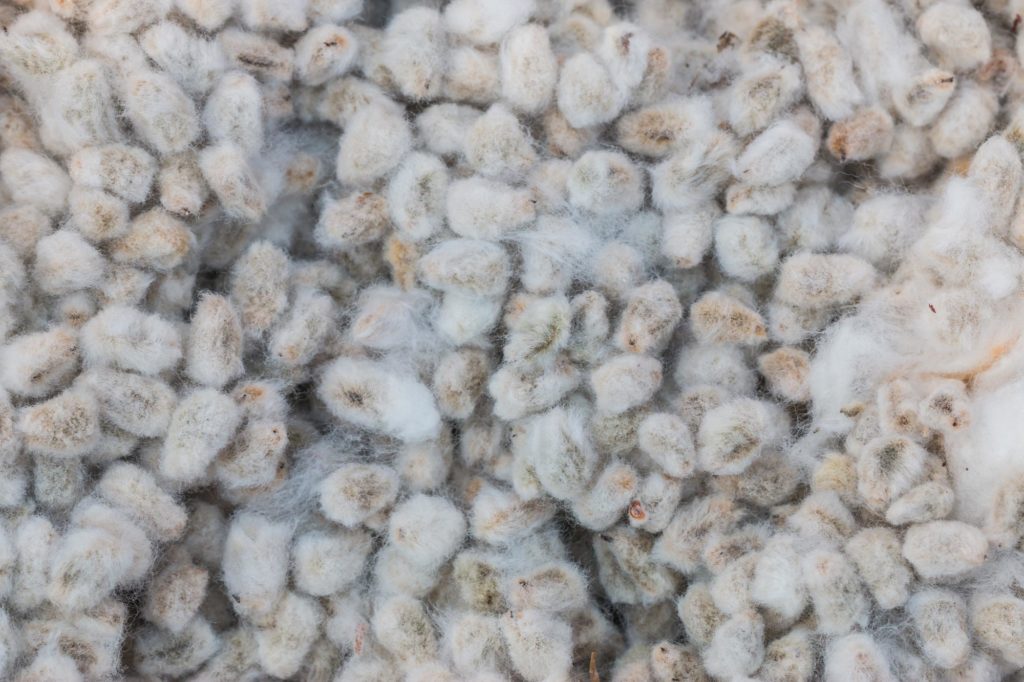How Cotton Goes From Field To Feed & Fiber
• Posted in Articles
Alisa Ogden’s family has raised cattle and grown cotton in the southeast corner of New Mexico for over a century. Her grandfather bought the farmland sight unseen as part of an opportunity to grow a new irrigation district started during the late 1800s. Soon after her grandparents got married and moved to the desert to start a farm together.
“He was from Pennsylvania, she was from Iowa and they met in Kansas so I’m sure they were in complete shock when they arrived in the desert of New Mexico,” Ogden said. They established the farm by growing alfalfa and cotton in addition to small grains. Today, Ogden, and her brother run a cow-calf ranching operation and farm south of Carlsbad. She not only grows cotton to create textiles and oil for cooking, but has also included cottonseed in cattle rations due to its nutritional value.
“We background our cattle, feeding about 2-2.5 lbs. of whole cottonseed daily to our calves along with alfalfa hay and sorghum in bunks. Cottonseed is a smart choice because it’s a complete ingredient that provides protein, fat and fiber1,” said Ogden who notes they have used gin trash in the past for roughage.
Since they only feed a portion of the cottonseed they grow, most of it is sold to seed companies and local dairies after processing. She works with Jesus Pando and Artesia Alfalfa Growers Association to help her cotton reach its final destinations.

The Farmer & Ginner Connection
The relationship between growers and ginners is strong in New Mexico. Pando is a certified ginner who has been working in the business for 18 years. Before joining Artesia Alfalfa Growers Association about 8 years ago, he worked with his uncle who owns the only other gin in the state.
“We’re relatively small compared to other gins across the country, but we’re always looking for ways to process more, grow our efficiency and produce the best quality lint for our farmers. When we started in 2015, we ginned 10 bales per hour. Now we’re up to 18,” explained Pando who went on to note that the cooperative processes about 10,000 bales of cotton per year.
Pando works with his father and one other employee regularly throughout the year. They scale up their labor force during harvest to ensure customers get the cotton they grow within the same year it’s planted. From Thanksgiving to Christmas, this often means running the gin 24 hours per day with multiple shifts.
“It’s time and labor intensive but so is growing the cotton. We all care about each step of the process that helps produce high-quality products for the end users,” said Pando.
Behind The Scenes Of Growing, Ginning & Selling Cotton
It all starts in April, when Ogden prepares the fields for planting. While some cotton growers have switched to planting flat, Ogden continues plant her cotton on beds, which involves building up rows, watering, mulching, and cultivating after the plant has sprouted. This allows her to channel the water where she wants it to go and helps reduce weeds.

Ogden plants GMO cotton varieties because they are pest-resistant and reduce the need for her to spray for insects like cotton boll weevil, which used to devour crops. Cotton thrives in hot weather and doesn’t need as much water as alfalfa hay, so usually, her allotment from the Pecos River and a couple of well-timed monsoon rains are typically all that’s needed to help it grow.
Cotton signals it’s ready for harvest when the bolls open to expose fluffy, white lint. This typically happens in October. The last step before picking is to defoliate or desiccate the green foliage so it doesn’t stain the lint.
“Cotton is grown for its lint because that’s what generates the most money. However, the more seeds a plant has, the more lint it produces so it’s a win for textile companies and producers who feed it,” explained Ogden.
As the cotton is harvested, it’s built into modules. Module size depends on the type of equipment used but can range from 4,000 to 12,000 pounds and 32 feet long. Once the modules are ready, Ogden coordinates pick up and transportation with Pando so the ginning process can begin.
Pando and his crew transport the modules to the facility where they’re numbered and tested for moisture.
“Modules must be at 7% moisture or less to run through the feeder,” said Pando.

From there the modules are broken down into bales, which then go through a feeder that blows hot air to dry them further. After the feeder, a different machine separates the sticks, burs and motes (gin trash) from the cotton and sends the cotton on to another machine that pulls the lint from the seeds. The seed goes to the seed house, while the lint is cleaned, compacted into 500-lb. bales, tagged, sampled for government grading and shipped to a warehouse for storage.
“We don’t have storage at the coop so everything we process must be sold or shipped to warehouses immediately,” said Pando. This is why they sell most of their cottonseed locally and it goes into contract pretty fast.
Selling cotton can be a multi-step process since the lint and seeds have different uses.
Farmers contract with marketing companies that buy and store the bales of lint before reselling the lint to textile companies. Most farmers sell the seed to the gin and can use the proceeds to offset the cost of ginning. The coop then sells the seed and gin trash to dairies as feed.
However, some seed companies contract with farmers in the spring to grow cotton for seed production. After harvest, farmers keep the lint to sell to their marketers, and the seed companies “catch the seed” to process for seed to plant the next year.

“About 60% of the cottonseed we gin becomes feed for local dairies and about 40% is sold as catch seed,” said Pando. “The gin trash, which includes burs and sticks, is also sold for supplemental roughage at about $60 a ton for feed.”
As a cotton and cattle producer, Ogden loves that she gets a front row view of the process. While a lot has changed since her grandparents founded the family business, feeding whole cottonseed is timeless ingredient that continues to provide quality nutrition to her cattle.
For more information on how you can connect with a cottonseed supplier near you, visit our Cottonseed Marketplace.
1 Kellogg, D.W., Pennington, J.A., Johnson, Z.B. and Panivivat, R. (2001). Survey of management practices used for the highest producing DHI herds in the United States. J. Dairy. Sci. 84, Supplement, E120– E127. doi:10.3168/-jds.S0022-0302(01)70206–8.

